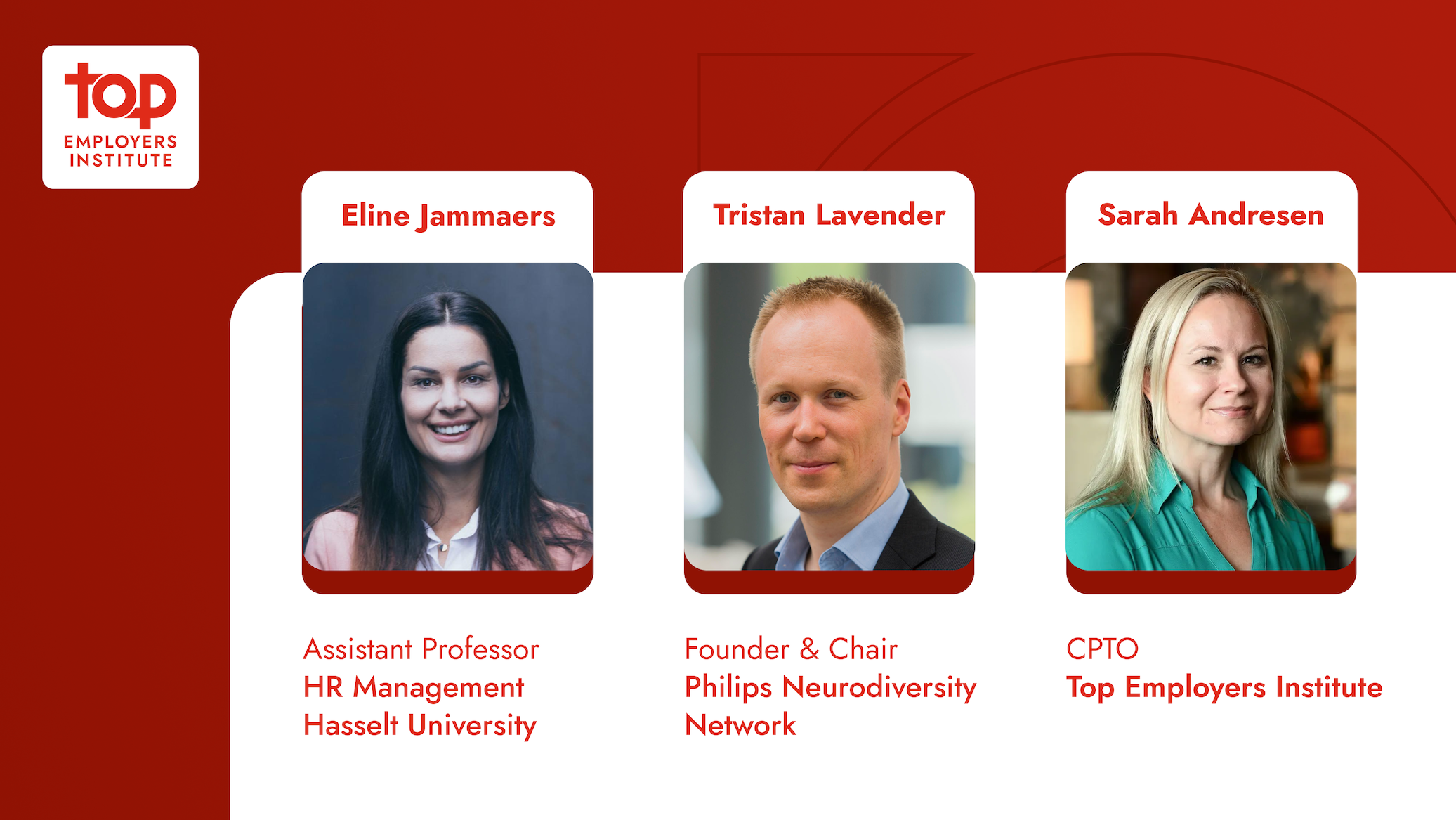Our recent webinar, Neuroinclusion in the workplace: From awareness to action, showed HR leaders how to take a giant leap forward from understanding the importance of neuroinclusivity to embedding it across leadership and teams at every level of an organisation.
Sarah Andresen, Chief Product and Technology Officer at Top Employers Institute discussed best practice neuroinclusivity with Eline Jammaers, Assistant Professor at Hasselt University and Tristan Lavender, Founder & Chair of Philips Neurodiversity Network.
The case is made, so let’s move to action.
HR leaders should already know that neuroinclusion helps organisations widen their talent pool, unlock latent potential and create stronger, more connected teams. There is no shortage of research showing that inclusive organisations have a better chance of meeting the expectations of socially-conscious consumers, while employees working there are more likely to feel engaged – and stick around.
Top Employers Institute’s new paper Neuroinclusive by design: Creative and thriving team environment for all echoes these findings and goes much further. It identifies three features of thriving, inclusive teams: harnessing individual talents, co-creating clarity and embracing empathy to drive better business performance.
Below are just some of the practices that the webinar looked at to show best practice inclusivity in action.
1. Start with leadership: Role models set the tone.
Senior leaders play a pivotal role in introducing neuroinclusive practices. When leaders are open about their own neurodivergence, it sends a powerful and positive message. It normalises differences and encourages psychological safety, especially among younger employees and others unsure about disclosing their neurodivergence.
Line managers are also vital role models. Their ability to sit and to listen, respond with flexibility and ask the normal day-to-day questions, such as ‘What support would help you do your best work?’ can be transformative.
One enduring myth that the webinar also explored is when neurodiversity is billed as bringing ‘superpowers’ to the workplace. While neurodivergent employees do bring unique strengths, these must be wholeheartedly supported. The true value of neurodivergence is only unlocked with the active encouragement of leaders and managers; a passive acceptance that we are all different is simply not enough.
2. Continue with teams: Embed psychological safety as an everyday instinct.
To move inclusion beyond good intentions means teams must also play their full part. Psychological safety needs to be a daily given, built through small, consistent behaviours. Both leaders and their teams should, for example, ask new hires about communication preferences, environmental needs or work styles as an instinct, without the need for a formal diagnosis. Simple common-sense actions like these have a wider purpose – they reduce barriers and improve collaboration among not only neurodivergent employees but everyone.
Inclusion happens in these ‘micro-moments’ of work: how to run meetings, give feedback, and handle discussions. Leaders and teams need to model empathy and openness, not just in policy but in day-to-day behaviour, until it becomes deeply embedded.
This needs to be visible externally, to attract future talent. Personal stories of neuroinclusion attract the job candidates of the future, as well strengthening internal alignment.
3. Reinforce through ERGs and metrics: A key role for HR.
Our Neuroinclusive by Design research describes a necessary mindset shift from ‘accommodation’ to ‘intentional inclusion’, building flexibility, clarity and empathy proactively into team culture from the outset. And HR has a key role to play in driving this forward in several ways.
For example, Employee Resource Groups (ERGs) are a powerful tool for accelerating inclusion. They provide safe spaces for connection, education and advocacy. For them to flourish, HR leaders must support them in a similarly active way, with funding, time and clear links to organisational strategy.
The webinar showed how companies like Philips have introduced formal neuroinclusion policies at a national level to make sure that ERG insights translate into organisation-wide support. And this is the kind of structural reinforcement that Top Employers’ new platform, HREdge | NeuroInclusion, has been designed to support. It provides the necessary tools, insights and expert guidance for embedding inclusion across the employee lifecycle.
Measuring neuroinclusivity also remains a challenge for many employers. One practical way for HR to play a role is to embed questions within existing wellbeing or engagement surveys, to align with key desired outcomes like job satisfaction or a sense of belonging. This requires trust, with participants needing to believe that their responses will not only be anonymous but used constructively. ERGs can play a unique role here too, for example through running pulse surveys or providing qualitative insights from neurodivergent communities.
Final word…
Neuroinclusion by design in 2025 is no longer only for the neurodivergent. It is a journey from awareness to action for all, a framework for designing better work for everyone, at every level of an organisation.
To explore how to start or scale your neuroinclusive practices, download our research paper or for tailored business recommendations and benchmarking solutions, find out more about our new platform, HREdge | NeuroInclusion.
